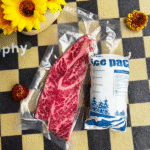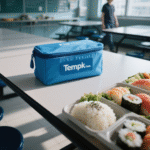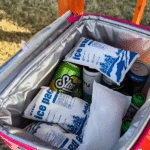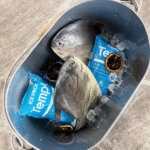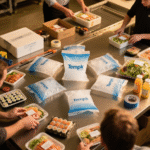So verwenden Sie eine wiederverwendbare Trockeneisfolie für den Außenbereich?
Einführung:
When you’re heading out for a picnic, Campingausflug, or outdoor food delivery, a reusable dry ice wrap gives you reliable cooling performance in the field. Richtig verwendet, it can hold cold for up to 48-72 hours and reduce waste compared with single-use ice. This guide will walk you through choosing, preparing, and applying a reusable dry ice wrap in realistic outdoor scenarios.
-
What exactly is a reusable dry ice wrap and how does it work in outdoor use?
Learn about the science behind dry ice sublimation and why wraps are more efficient than gel packs or block ice. -
How do you safely use a reusable dry ice wrap outdoors?
Tips on packing, layering strategies, and safety precautions for keeping your food or goods safe outdoors. -
What benefits do reusable dry ice wraps offer compared to traditional cooling methods?
Explore the cost savings, Nachhaltigkeit, and moisture-free cooling advantages. -
How do you choose the right size and cooling capacity for your outdoor cooler scenario?
A buying guide on selecting the perfect reusable dry ice wrap for your needs. -
Was sind die neuesten Trends in der Trockeneistechnologie und Kühlkettenverpackung? 2025?
Learn about biodegradable coatings, Smart Sensoren, and customized packaging innovations.
What exactly is a reusable dry ice wrap for outdoor use?
A reusable dry ice wrap is a flexible, insulated sheet (or pack) designed to hold a block or pack of dry ice (Festes Kohlendioxid). Trockeneis sublimiert bei -78,5 °C (-109.3° F), providing ultracold temperatures for extended periods. Unlike gel packs that melt into water, dry ice directly converts into gas, keeping your contents cold without creating a mess. The wrap’s insulation slows down the sublimation process, ensuring longer cooling times. Many wraps use polymers or fabric with thermal reflective layers, making them reusable, kostengünstig, and more sustainable than single-use ice packs.
Why is this important for outdoor use?
-
Portabilität & Flexibilität: These wraps can bend around items in a cooler, fit along walls, or wrap odd-shaped gear.
-
Wiederverwendbarkeit: Freeze once and reuse multiple times—saving cost and reducing waste.
-
Better Insulation Fit: By placing them along the sides and top of coolers, you reduce ambient heat intrusion.
-
Safer Handling: No handling of extreme cold (Trockeneis), making it safer than traditional dry ice blocks.
What cooling performance can you expect from outdoor-use wrap?
Understanding the performance metrics of reusable dry ice wraps can help you maximize their benefits outdoors.
| Parameter | Typischer Wert | What it means for you outdoors |
|---|---|---|
| Freezer temperature before use | ~ -20°C (-4° F) oder niedriger | You’ll get longer cool retention if frozen as cold as possible. |
| Placement guideline | One sheet per ~7 qt cooler | Make sure to have enough wrap relative to your cooler size. |
| Duration estimate | Bis zu 48-72 Std. | For most outdoor trips, this will last the entire duration. |
| Refreeze reuse cycles | Mehrere Verwendungen (dozens) | Saving costs and waste compared to single-use packs. |
Tipp: The better the cooler insulation and fewer door openings, the more effectively the wrap keeps items cold.
How do you choose the right reusable dry ice wrap for outdoor use?
Choosing the right wrap is essential to optimize performance. Consider these key factors:
Key Selection Criteria:
-
Sheet size & Form: Ensure it fits your cooler walls or wraps around items directly. Zum Beispiel, a wrap sized 9.5” x 16” is flexible and covers a variety of shapes.
-
Freezable temperature rating: Check how low the wrap can freeze. Many wraps are effective when frozen between -18°C to -21°C.
-
Haltbarkeit & reuse potential: Look for wraps made from thick laminate or multi-layer materials that can handle multiple freeze cycles.
-
Compatibility with cooler volume: Use one sheet per approximately 7 qt cooler.
-
Outdoor suitability: Ensure the wrap resists punctures and can handle motion or vibration, ideal for outdoor transport.
Best practices for prepping and using the wrap outdoors
Here’s how to get the most out of your reusable dry ice wrap:
How to freeze and load the wrap:
-
Freeze well in advance: Place the wrap in your freezer at maximum cold setting for 24-48 Stunden vor dem Gebrauch. A deep freeze will give you longer retention.
-
Kühlen Sie Ihren Kühler vor & items: Cold items require less “cold work” from the wrap, so pre-chill both your cooler and the items inside.
-
Strategic loading: Place one sheet at the bottom or sides of the cooler, add your items on top, and cover with additional sheets on top for maximum cooling.
Minimize air gaps & opening frequency:
Jedes Mal, wenn Sie den Kühler öffnen, Warme Luft tritt ein, reducing the wrap’s effectiveness. Monitor your cooler to maintain consistent temperatures, especially if shipping high-value perishables.
Real-world application tips
Camping scenario:
On a hike, pack perishable food and drinks. Freeze two wrap sheets overnight, load the cooler with one sheet beneath items and one sheet on top, and only open the cooler once upon arrival. Your food will stay cool for the entire trip.
Lebensmittel Lieferung:
Wrap your chilled meals in the dry ice wrap, ensuring it stays around the high-value items to maintain the target temperature, especially during outdoor deliveries.
Medizinisch / vaccine-like outdoor transport:
Für gekühlt (nicht gefroren) items, a reusable wrap is a safer, lighter alternative to solid dry ice blocks. It’s ideal for transport in vehicles or tents.
2025 latest developments and trends in outdoor reusable cooling wraps
Trends overview:
The outdoor cooling industry is evolving, with a focus on sustainability and efficiency. In 2025, we see advances in biodegradable coatings, hybrid systems, and greater use of phase-change materials.
Latest progress:
-
Prolonged cold life: New wraps are designed to maintain lower temperatures longer, even under repeated freeze/thaw cycles.
-
Hybridsysteme: Some cooling solutions now pair wraps with insulation and active cooling triggers to extend performance.
-
Eco-materials: Biodegradable and compostable materials are gaining traction in wrap manufacturing, supporting sustainability goals.
FAQ
Q1: Can I really reuse a dry ice wrap multiple times for outdoor use?
Ja, unlike solid dry ice which sublimates away, a reusable dry ice wrap uses a gel or polymer that can be refrozen and reused multiple times. Just follow freezer prep and storage guidelines.
Q2: How long will the reusable dry ice wrap keep items cold outdoors?
In a well-insulated cooler, the wrap can hold cold for 24-72 Std., depending on ambient temperature and how often the cooler is opened.
Q3: Is a reusable dry ice wrap safe to use for food outdoors?
Ja, provided it’s food-safe rated, properly sealed, and kept clean. Many wraps are designed specifically for perishables and avoid the mess associated with meltwater.
Q4: Can I mix the wrap with regular ice to extend cooling?
It’s possible, but manufacturers warn not to mix with regular ice, as it can absorb cold from the wrap, reducing its retention.
Abschluss & Key Takeaways
A reusable dry ice wrap is a valuable tool for outdoor use, providing extended cold retention without the mess of meltwater. By selecting the right wrap and following best practices, you can reduce waste, maintain freshness, and enjoy cost savings. With emerging trends like biodegradable coatings and smart sensors, reusable dry ice wraps are poised to play a key role in the future of sustainable cooling.
Aktionsschritte
-
Select a wrap that fits your cooler and outdoor needs.
-
Freeze the wrap at maximum cold setting for 24-48 hours before your trip.
-
Vor-Chill your cooler and items to maximize efficiency.
-
Überwachen Sie die Temperatur Während des Transits, especially for high-value items.
Über Tempk
Tempk specializes in providing high-performance temperature control solutions for outdoor and logistics applications. With our expertise in cold chain solutions, we offer reusable cooling wraps and premium insulation systems to help you maintain freshness and reduce costs.

















